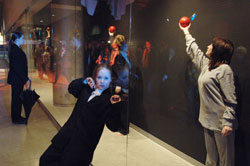Quarter-century of contemporary dance

Even the vitrines outside of the FOFA Gallery were pressed into service as a performance venue as the contemporary dance department infiltrated various corners of the EV building for their March 1 gala.
Ryan Blau
“If you can turn your passion into your profession, you will be the happiest person in the world.”
Choreographer Elizabeth Langley, who was addressing the audience assembled on March 1 for the 25th anniversary of Concordia’s Contemporary Dance Department, was sharing the advice her father, who was also a dancer, had given her when she was just embarking on her career.
The first department head enlisted to direct a program that unusually, for a university, teaches choreography as well as technique, joked that whether he was “looking down or up on us now,” the late Dean Alfred Pinsky would be proud to see that the department has never wavered in this mission.
Onlookers in the crowd massed in the central hall of the Integrated Engineering, Computer Science and Visual Arts Complex on the evening of March 1 were hard pressed to keep up with the many layers of choreography produced by Contemporary Dance students in celebration of their department’s 25th anniversary.
Tiers of dancers performed duets while the audience took their seats for the second part of the event in the Black Box, filled with soft light refracted through smoke. Following remarks from past department heads Silvy Panet-Raymond and Elizabeth Langley, seven pieces by students and alumni covered a gamut of styles.
“Into the Unknown” by K8 Alsterlund and Forty Nguyen was set to music by MC Solaar and incorporated hip-hop moves. Alumni Pierre-Paul Savoie’s “Corps étranger” included spoken poetry and some rocking Johnny Cash. “La Valse,” an excerpt from David Albert-Toth’s “scale,” was set to tango-like Frehel.
The overall effect, as the evening continued on the rooftop terrace, where a series of eight more pieces was performed against the dramatic backdrop of the lights of downtown Montreal, was of continuous, seamless choreography.
In her closing thanks, Dean of Fine Arts Catherine Wild picked up on a sentiment expressed by department heads past and present and professors throughout the evening. “Seeing the dancers use spaces throughout the building is really inspirational.”
Individuality and diversity have been hallmarks of the department, according to Philip Szporer, a dance critic who teaches Dance Traditions. He finds working among dance students is an enriching experience.
“At Concordia, you are literally surrounded by generations of new voices. They are here, in the now,” Szporer said. He sees the department as having a ripple effect not only on the Montreal dance scene, but the Canadian and international scenes.
Orchestrating an evening that involved multiple performances in three locations — the ground floor, the Black Box, and the rooftop terrace — was a complex creative feat said department chair Michael Montanaro. In September, he presented his third-year creative process students with the overall structure of the event. Three teams, one per performance area, were tasked with working out the details of each component.
And there were more than a few creative details to work out. Originally, 18 dancers were to be involved. But that number mushroomed to 61, including 12 alumni. At the party following the rooftop performance, Montanaro gave his students kudos. “It was a difficult project that took a lot of focus and dedication on their part. They worked really hard.”
At the post-performance party, alumnus Pierre-Paul Savoie said his piece, which dealt with memory, suited the event, which was after all an anniversary and a reunion. Explaining the personal nature of the discipline of dance and the strength of the family-like bond dancers share, he said, “You can learn math, or science, or philosophy. But the kind of relationship you have with dance is physical, and emotional, and intellectual. Dance is a full experience. It shows you things.”
Looking around the room, which was packed with mingling students, professors and alumni, he gestured happily. “You see? Dancers don’t age!” Langley Père must have been right.
To see QuickTime videos of students’ works, go to: dance.concordia.ca/videos.html